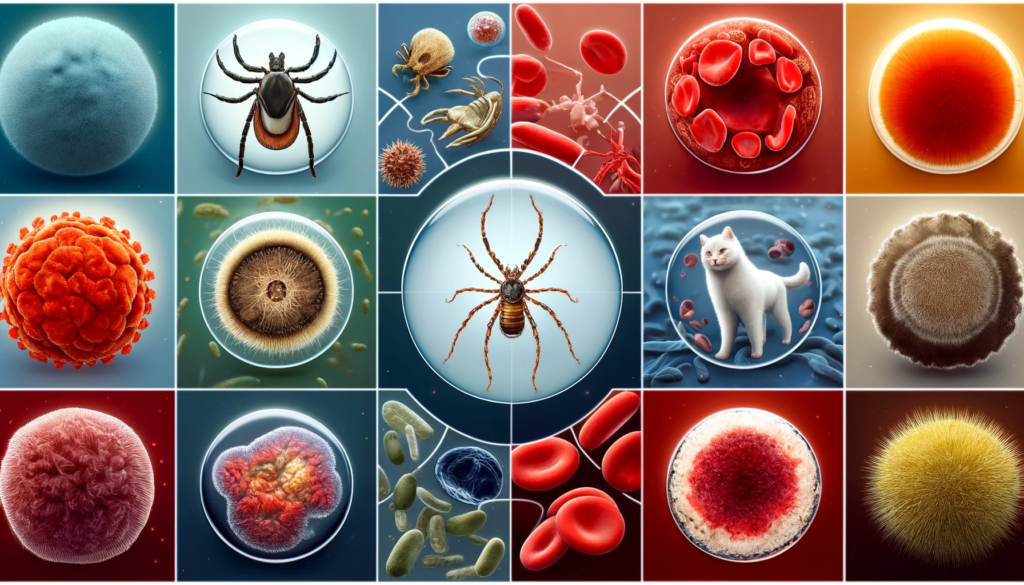
Written by Dr. Diane Mueller
Hey there! You know, Lyme disease has been getting a lot of buzz lately. But it’s not only about the disease itself that has everyone talking – it’s also the other organisms that come along with it. We’re going to dive deep into the world of Lyme co-infections, how we spot ’em and why they’ve become such a hot topic in the health space. We’ll also chat a bit about ticks – especially those Lone Star Ticks and American dog ticks – and their part in this whole unsettling trend. So strap in, as we dive into Lyme co-infections.

The simultaneous presence of Lyme disease and other pathogens, known as co-infection of Lyme disease, has become an issue because of its high occurrence rate and potential to complicate diagnosis and treatment processes.
Ticks are the main carriers of Lyme disease and can host various types of pathogens. As climate change impacts tick migrations, the risk of humans being exposed to these pathogen transmitting carriers increases.
Lyme disease often occurs alongside infections such as Anaplasma phagocytophilum, different Babesia species, Bartonella species, and Rickettsia species. Identifying these infections is vital to accurately diagnose the disease and improve treatment results.
The diagnosis process poses challenges due to the presence of multiple pathogens and the complexity in determining infection sequences. Improving testing methods, including systematic serologic testing and advanced DNA sequencing techniques, is key to accurate detection.
Lyme disease and its co-infections are usually treated individually. However, treating multiple infections at once can be challenging due to ‘herxheimer reactions’, or immune responses caused by dead bacteria in the body.
Have Lyme Disease or suspect you do?
We have helped thousands of people restore their health and quality of life by diagnosing and treating their Lyme Disease
Lyme co-infections, or the simultaneous infection of Lyme disease with other pathogens, is a topic to be aware of. A couple years back, LymeDisease.org did a survey of 3,000 folks dealing with chronic Lyme disease, and guess what? More than half of them had lab-confirmed co-infections. To make things even more serious, almost a third were dealing with two or more. There’s a number of studies suggesting Lyme co-infections might actually be more common than single infections.
Ticks, the vectors of Lyme disease, typically carry multiple pathogens, contributing to a high incidence of co-infections. A study in France found that every tick tested was carrying at least one symbiont and 45% carried up to five different pathogens. The range and diversity of infectious agents complicate the diagnosis and treatment of Lyme disease, often resulting in patients dealing with multiple illnesses simultaneously.
Many Lyme patients don’t suffer from just one infection but, often, multiple. Co-infections represent an escalating issue, with some capable of emulating Lyme’s clinical features, complicating the disease diagnosis and treatment. In this section, you’ll further understand the various common Lyme co-infections infecting patients.
Anaplasma phagocytophilum is a prominent co-infection to Lyme disease. Should you find yourself in Valhalla, New York, with an existing Lyme disease diagnosis, you may need to check for this particular strain. However, you shouldn’t concern yourself excessively, as it does not generally compound the symptoms associated with Lyme disease substantially. It is advisable, though, to be alert to occurrences of leukopenia and thrombocytopenia potentially increasing in frequency, as this may be indicative of Anaplasma phagocytophilum operating independently.
Babesiosis represents another Lyme disease co-infection. Caused by multiple Babesia species, the dominant strain varies by location, with Babesia microti more common in U.S tick populations, while Babesia divergens takes precedence in Europe. As the infection is meant to nest within erythrocytes, patients can experience haemolysis of varying severity, leading to fever and flu-like symptoms.
Bartonella species also appear among Lyme disease co-infections. They play a contributory role in escalating the disease’s severity, prompting similar clinical features with Lyme disease. Hence, accurate diagnosis demands a prudent approach towards identifying the presence of this co-infection.
Also lurking within the Lyme disease co-infections inventory are Rickettsia species. Detecting this co-infection requires meticulous testing and clinical observation, given its potential to duplicate Lyme disease symptoms. The presence of Rickettsia species within a patient’s profile can significantly alter the course of treatment.

Determining the sequence and simultaneity of infection with multiple pathogens also poses another diagnostic impediment. For instance, identifying whether a patient contracted the infections simultaneously or sequentially could be challenging. Serological studies, even though indicating antibodies’ prevalence to multiple tickborne co-infections among patients with Tick-Borne Diseases (TBDs), fail to examine the incidence and pathophysiological effects of simultaneous infections adequately.
The advent of state-of-the-art technologies, notably high-throughput DNA sequencing and dual index barcoding made upgrades to disease detection. Particularly, the dual index barcoding, by enabling parallel evaluation of 50 samples, has scaled up the efficacy and accuracy of diagnostic processes. Such advancements show the need for continual progression in testing methodologies to proficiently tackle the challenges posed by Lyme disease and co-infections.
It is essential for your Lyme Literate doctor to maintain perpetual vigilance and continuous innovation in the field of Lyme disease identification and co-infections.
The treatment of Lyme disease and associated infections is complicated due to the variety of infectious agents involved. However, implementing thorough treatment plans is crucial for successfully managing these conditions.
When dealing with Lyme and its co-infections, understanding the individual and collective impact of each infectious agent becomes imperative. Treatments typically target the each infection individually, taking into account the unique characteristics and pathogen factors of each disease.
For instance, following a confirmed Lyme diagnosis, you’d begin a targeted antibiotic regimen which could include medicines like doxycycline or amoxicillin. On the other hand, if diagnosed with a co-infection like Anaplasmosis, a different sequence of antibiotics might be necessary, such as doxycycline or rifampin.
Simultaneously managing multiple infections can pose unique challenges. In some cases, simultaneous treatment of Lyme and its co-infections might lead to debilitating ‘herxheimer reactions’, an immune response to dead bacterial cells in the body. But, concurrent treatment is often necessary to control disease progression.
Co-infections can also play a significant role in the effectiveness of Lyme disease treatment. Research indicates that these co-infections can complicate the disease’s manifestation, making it harder to detect and treat effectively. Besides, some co-infections might also induce treatment resistance, reducing the efficacy of conventional Lyme disease antibiotics.
An additional challenge is that the presence of co-infections can often mimic or exacerbate Lyme symptoms, leading to misdiagnoses or ineffective treatment strategies. Hence, it’s of utmost importance that health providers maintain a high index of suspicion for possible co-infections in Lyme disease patients, to ensure more accurate diagnostics and optimized treatment plans.
To conclude, dealing with Lyme and its co-infections requires a blend of fine-tuned diagnostic techniques and personalized treatment strategies. As the field of Lyme disease management continues to evolve, it remains hopeful that improved diagnostic tools and effective treatments are on the horizon.
This piece talks about how tough it can be to diagnose and treat Lyme disease and co-infections. It stresses the need to upgrade our diagnostic technologies and take a step-by-step approach to testing. There’s also a shout-out to strategies that are a match for each bug. Juggling multiple infections ain’t easy for any practitioner, which makes it more difficult to provide the correct treatment plan. Wrapping it up – be sure to work with a Lyme Literate Doctor who understands the latest diagnostic tools, tailor-made treatments, and staying up to date in the Lyme world.
References:
Berghoff, W. (2012). Chronic Lyme Disease and Co-infections: Differential Diagnosis. The Open Neurology Journal, 6, 158 – 178. https://doi.org/10.2174/1874205X01206010158.
Schoen, R. (2020). Challenges in the Diagnosis and Treatment of Lyme Disease. Current Rheumatology Reports, 22, 1-11. https://doi.org/10.1007/s11926-019-0857-2.
You can learn more about Lyme Disease and the impact of Lyme Disease tick bites in our other articles below:
We have helped thousands of
people restore their health
and quality of life by diagnosing
and treating their Lyme Disease.
“Dr. Mueller’s approach to medicine is refreshing! There is only so much you can do with western medicine and in my life I was needing a new approach. By addressing the whole body, nutritional diet factors, environmental factors, blood work, and incorporating ideas I had not previously known, I was able to break through with my conditions. I am not only experiencing less pain in my life, but through the process of healing guided by Dr. Diane Mueller, I am now happy to say I have more consciousness surrounding how I eat, what to eat and when things are appropriate. Living by example Dr. Mueller has a vibrancy that makes you want to learn and know more about your body and overall health. I highly recommend her to anyone looking for new answers, a new approach to health, or in need of freedom from pain and limitations.”
-Storie S.
Kihei, HI
Have Lyme Disease or suspect you do?
[i] Stephanie Richards, Ricky Langley, Charles Apperson, and Elizabeth Watson, “Do Tick Attachment Times Vary between Different Tick-Pathogen Systems?,” Environments no. 2 (September 2017): 37, doi:10.3390/ environments4020037.
Ebel GD, Kramer LD. Short report: duration of tick attachment required for transmission of powassan virus by deer ticks. Am J Trop Med Hyg. 2004;71(3):268-271.
Chien-Ming Shih and Andrew Spielman. “Accelerated Transmission of Lyme Disease Spirochetes by Partially Fed Vector Ticks,” Journal of Clinical Microbiology 31, no. 11 (November 1993): 2878–81.
